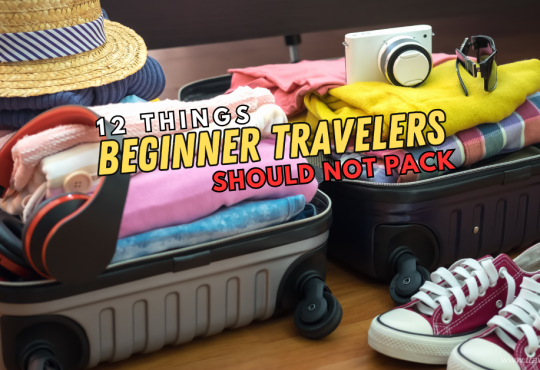
Are you dreaming of an adventure in a tropical paradise without breaking the bank? Look no further than Southeast Asia! With its stunning beaches, rich cultures, and mouthwatering cuisine, Southeast Asia is not only a traveler’s dream but also one of the cheapest travel destinations in the world. Whether you’re a backpacker on a budget or just looking for an affordable getaway, this region offers a wealth of experiences that won’t empty your wallet. In this guide, we’ll explore why Southeast Asia is the go-to spot for budget travelers, how to manage your expenses, and how much you can expect to spend while wandering through this vibrant part of the world.
Southeast Asia is a melting pot of diverse cultures, breathtaking landscapes, and some of the friendliest people you’ll ever meet. From the bustling streets of Bangkok to the serene beaches of Bali, each destination offers something unique at prices that are often surprisingly low. This article will give you practical tips on budgeting for your trip, a breakdown of potential costs, and suggestions for must-visit destinations that prove to be the cheapest travel destinations. So, pack your bags and get ready for a journey that won’t just feed your wanderlust but also keep your finances in check!
Why Southeast Asia is One of the Cheapest Travel Destinations
Southeast Asia consistently ranks as one of the most budget-friendly regions for travelers. From stunning landscapes to rich cultural experiences, there are several reasons why you can explore this vibrant area without breaking the bank. Here are the key factors contributing to the affordability of traveling in Southeast Asia:
1. Low Cost of Living
The cost of living in Southeast Asia is significantly lower than in many Western countries. This translates to cheaper prices for essential goods and services.
- Accommodation: Local guesthouses, hostels, and budget hotels offer a range of affordable options, often under $30 per night. In many cities, it’s possible to find a clean and comfortable room for as low as $5 to $15.
- Food: Street food is not only a culinary delight but also incredibly cheap. You can enjoy delicious, filling meals for just $1 to $3. Local restaurants also serve hearty dishes at very reasonable prices, making it easy to eat well on a budget.
- Transportation: Public transport, including buses and tuk-tuks, is inexpensive. A short taxi ride might cost only a couple of dollars, while long-distance travel by bus or train is also budget-friendly, often under $20.
2. Affordable Attractions and Activities
Many of Southeast Asia’s attractions, such as temples, national parks, and local markets, are either low-cost or free.
- Cultural Experiences: Visiting iconic sites like Angkor Wat in Cambodia or the temples in Thailand typically involves low entrance fees, usually between $1 to $30. Free activities, such as exploring beaches or hiking in national parks, abound.
- Excursions: Many tours, including cooking classes, guided treks, and diving trips, are priced affordably. Group tours can cost as little as $10 to $50, providing great value for the experience.
3. Exchange Rates and Local Currency
For travelers from countries with stronger currencies, the favorable exchange rates can make Southeast Asia even cheaper.
- Currency Advantage: When converting dollars, euros, or pounds to local currencies (like the Thai Baht, Vietnamese Dong, or Indonesian Rupiah), travelers often find they get more value for their money. This can make everyday expenses—like food, accommodation, and transportation—feel significantly cheaper.
- Cash Culture: In many Southeast Asian countries, cash is the preferred payment method, which can sometimes lead to better deals compared to card payments. Many local markets and smaller establishments offer discounts for cash payments.
4. Diverse Travel Styles
Southeast Asia caters to a range of travel preferences, from backpackers to luxury seekers. This diversity means that travelers can tailor their experiences to fit their budgets.
- Backpacking: With a plethora of hostels and budget accommodations, along with affordable street food and public transportation, backpackers can easily explore the region on as little as $20 to $50 a day.
- Mid-Range Options: For those wanting more comfort without splurging, mid-range hotels and dining options are readily available. Travelers can enjoy better amenities while still keeping expenses relatively low.
- Luxury on a Budget: Surprisingly, luxury experiences in Southeast Asia can also be affordable. Many upscale hotels and resorts offer competitive prices, especially during off-peak seasons, allowing travelers to enjoy high-quality service without high prices.
5. Strong Tourism Infrastructure
Southeast Asia has a well-developed tourism infrastructure, making it easier and more affordable to travel around.
- Transport Networks: Extensive bus, train, and ferry services connect popular destinations, allowing for easy and economical travel. Budget airlines also operate numerous routes, making flights affordable between countries.
- Local Agencies and Guides: Numerous travel agencies offer tours and packages at competitive rates. Local guides can often provide unique experiences at lower prices than international operators.
6. Friendly Locals and Community-Based Tourism
Southeast Asia is known for its warm hospitality, which often extends to affordability in local interactions.
- Community-Based Tourism: Many regions promote community-based tourism, where travelers can engage in local cultures and contribute to local economies. These initiatives often offer authentic experiences at reasonable prices, benefiting both visitors and the community.
- Negotiation Culture: Haggling is common in markets and for services like transport. While this may seem daunting, it often leads to better prices, allowing travelers to save even more.
7. Availability of Budget-Friendly Experiences
Finally, Southeast Asia is rich in experiences that won’t strain your wallet, from nature to nightlife.
- Nature Adventures: Activities like hiking, snorkeling, and exploring waterfalls often come at little to no cost. For example, visiting national parks or hiking trails can be a thrilling yet economical way to experience the natural beauty of the region.
- Night Markets and Festivals: Local night markets offer not only affordable food but also unique shopping experiences. Participating in local festivals can also be free and provide a deep dive into cultural traditions.
How to Budget for Your Southeast Asia Adventure
Planning a budget for your Southeast Asia adventure is crucial to ensuring a stress-free and enjoyable experience. With so many affordable options available, it’s easy to travel on a budget while still enjoying the region’s rich culture and stunning landscapes. Here’s a step-by-step guide to help you budget effectively for your trip.
1. Determine Your Total Trip Budget
Before diving into the specifics, start by establishing your overall budget. Consider how much you can afford to spend during your trip. Think about:
- Total Amount Available: Assess your savings and determine how much you’re willing to allocate to this trip.
- Trip Duration: Decide how long you plan to travel. Longer trips may require more extensive budgeting, while shorter trips may allow for splurges.
- Desired Experiences: Identify what experiences are most important to you, whether that’s luxury accommodation, dining, activities, or unique local experiences. This will help guide your budget allocation.
2. Break Down Your Expenses
Create a detailed budget by breaking down your expenses into categories. This will give you a clearer picture of where your money will go.
Accommodation
- Research Average Costs: Look up average accommodation costs in the countries you plan to visit. For example:
- Hostels: $5 – $15 per night
- Guesthouses: $10 – $30 per night
- Hotels: $20 – $50+ per night
- Luxury: $50 – $150+ per night
- Book in Advance: Consider booking your first few nights in advance to avoid last-minute price hikes, especially in popular tourist areas.
Food and Drink
- Daily Food Budget: Plan your daily food budget based on your preferences:
- Street Food: $1 – $3 per meal
- Local Restaurants: $3 – $7 per meal
- Western Restaurants: $5 – $15 per meal
- Try Local Cuisines: Eating at local spots can save you money while giving you an authentic experience.
Transportation
- Local Transport: Estimate your daily transportation costs, considering:
- Public Transport: $0.50 – $3 per trip
- Tuk-tuks and Taxis: $2 – $10 per ride
- Long-Distance Buses/Trains: $5 – $30 for intercity travel
- Domestic Flights: If flying between countries, budget $30 – $100 for tickets on budget airlines.
Activities and Sightseeing
- Entry Fees: Research the entrance fees for popular attractions, typically ranging from $1 – $30.
- Tours and Excursions: Set aside money for guided tours or excursions, budgeting around $10 – $50 each.
- Free Activities: Factor in time for free experiences like hiking, beach visits, and cultural festivals.
3. Create a Daily Spending Plan
Once you’ve estimated your expenses, create a daily spending plan based on your total budget and trip duration.
- Daily Allowance: Divide your total budget by the number of days you’ll be traveling. This will give you a clear daily allowance. For example, if your budget is $1,500 for a 15-day trip, your daily budget would be $100.
- Adjust Based on Priorities: If you plan to spend more on certain activities or experiences, adjust your daily budget accordingly. For instance, if you want to splurge on a luxury resort for a few nights, reduce your accommodation budget for the other nights.
4. Monitor Your Expenses
Keeping track of your spending while traveling can help you stay within your budget. Here are some tips for monitoring expenses effectively:
- Use Budgeting Apps: Consider using budgeting apps like Trail Wallet or Mint to track your daily expenses. These tools can help you categorize spending and see where your money is going.
- Keep Receipts: Save your receipts for accommodation, food, and activities to help you keep an accurate account of your expenses.
- Reassess Regularly: Take a few minutes each week to reassess your budget. If you’re overspending in one category, see where you can cut back in others.
5. Plan for the Unexpected
It’s always wise to have a buffer in your budget for unexpected expenses, whether it’s a medical emergency, a change in travel plans, or a spontaneous excursion.
- Emergency Fund: Set aside at least 10% of your total budget for emergencies. This will give you peace of mind knowing you have some financial flexibility.
- Travel Insurance: Consider purchasing travel insurance to cover unexpected medical expenses or trip cancellations. This is an added expense but can save you a significant amount of money in case of emergencies.
6. Seek Local Advice
When in Southeast Asia, don’t hesitate to seek advice from locals or fellow travelers on budgeting tips and affordable options.
- Ask Locals: Engage with locals to find the best budget restaurants and activities. They can often provide insights that guide you to hidden gems away from tourist traps.
- Join Travel Forums: Participate in online travel communities or forums, such as Lonely Planet’s Thorn Tree or Reddit’s r/travel, to gather tips and suggestions from fellow travelers.
How Much to Expect to Spend While Traveling in Southeast Asia
Traveling through Southeast Asia can be incredibly affordable, especially when compared to many Western countries. To give you a better idea of what to expect, we’ll break down costs by different expense categories and provide average estimates for daily spending.
1. Accommodation Costs
Accommodation is usually one of the most significant expenses for travelers, but in Southeast Asia, there are plenty of options to fit every budget.
- Backpacker Hostels: Prices can range from $5 to $15 per night. Many hostels also offer free Wi-Fi and common areas where you can meet fellow travelers. In popular destinations like Bangkok and Bali, the average price tends to be on the higher end, especially during peak tourist seasons.
- Guesthouses: For a bit more privacy, guesthouses typically charge between $10 and $30 per night. These establishments often provide a more local experience and can be found in both urban and rural areas.
- Hotels: Budget hotels generally cost around $20 to $50 per night. While they may be slightly pricier, you can expect added amenities like air conditioning and private bathrooms.
- Luxury Accommodation: For those looking to indulge, mid-range hotels and resorts typically range from $50 to $150 per night, offering exceptional value for money compared to Western standards.
2. Food and Drink Costs
Southeast Asia is famous for its delicious food, and the costs can be incredibly low.
- Street Food: A significant part of the culinary experience, street food is not only tasty but also budget-friendly. Meals can cost between $1 and $3. Dishes like Pad Thai in Thailand or Banh Mi in Vietnam are staples that won’t break the bank.
- Local Restaurants: Eating at local eateries or casual dining spots usually costs around $3 to $7 per meal. Look for places that locals frequent for the best prices and authentic flavors.
- Western Restaurants: If you’re craving a taste of home, meals at Western-style restaurants can range from $5 to $15. However, these options can be significantly more expensive than local fare.
- Beverages: Soft drinks usually cost about $0.50 to $1, while local beer can range from $1 to $3 at bars and restaurants. In tourist areas, prices may be slightly higher.
3. Transportation Costs
Getting around Southeast Asia is generally inexpensive, especially compared to Western countries.
- Local Transportation: Public transportation options, like buses and trains, usually cost between $0.50 and $3 for short trips. In cities, tuk-tuks and motorbike taxis are popular, with fares typically ranging from $2 to $10, depending on the distance.
- Long-Distance Buses and Trains: Traveling between cities is usually affordable, with prices ranging from $5 to $30. For example, a bus from Bangkok to Chiang Mai might cost around $10, while a sleeper train could be $15 to $25 depending on the class.
- Domestic Flights: For longer distances, budget airlines like AirAsia or VietJet often have promotions, allowing you to fly between countries for as little as $30 to $100. Booking in advance can result in even better deals.
4. Activities and Entrance Fees
Many of the activities in Southeast Asia are either low-cost or free, making it easier to stick to your budget.
- Cultural Sites and Temples: Entrance fees for temples and cultural sites are generally reasonable. For instance, Angkor Wat in Cambodia has a ticket price around $37 for a day pass, while smaller temples may charge just $1 to $5.
- Tours and Excursions: Group tours to popular destinations or activities like cooking classes and guided hikes typically range from $10 to $50. Private tours can be more expensive, often costing between $50 and $150.
- National Parks: Entrance fees for national parks are usually around $5 to $10, with additional costs for guided tours or specific activities like zip-lining.
5. Daily Budget Estimates
To give you a clearer picture of your daily expenses, here’s a breakdown based on different types of travelers:
| Expense Category | Budget Traveler | Mid-Range Traveler | Luxury Traveler |
|---|---|---|---|
| Accommodation | $5 – $30 | $30 – $70 | $70 – $150 |
| Food | $5 – $15 | $15 – $30 | $30 – $70 |
| Transportation | $5 – $10 | $10 – $20 | $20 – $50 |
| Activities & Tours | $5 – $20 | $20 – $50 | $50 – $100 |
| Total Daily Cost | $20 – $75 | $75 – $170 | $170+ |
6. Additional Tips for Saving Money
- Travel Off-Peak: Prices for accommodation and flights tend to be lower during the off-peak season (May to October for most Southeast Asian countries).
- Negotiate: Haggling is common in markets and for transportation. Don’t be afraid to negotiate prices, especially for tuk-tuks and souvenirs.
- Use Local SIM Cards: Buying a local SIM card for data can help you save money on navigation and communication while traveling.
- Stay Flexible: If you’re open to changing your itinerary, you can take advantage of last-minute deals on accommodation and tours.
- Travel Insurance: While this may seem like an added expense, having travel insurance can save you money in case of unexpected emergencies.
Top Cheapest Travel Destinations in Southeast Asia
1. Thailand
Thailand is a traveler’s paradise, offering a mix of culture, adventure, and relaxation—all at budget-friendly prices.

- Must-See Places:
- Bangkok: Explore the Grand Palace, Wat Pho, and vibrant street markets.
- Chiang Mai: Famous for its temples and night bazaars, this city is a hub for adventure activities like trekking and zip-lining.
- Phuket: While a bit more touristy, you can find affordable accommodation and beautiful beaches.
- Budget Breakdown:
- Accommodation: Hostels can cost around $8-$15 per night. Guesthouses range from $10-$30.
- Food: Street food is cheap, with meals costing $1-$3. Dining in local restaurants can range from $5-$10.
- Transportation: Local buses and tuk-tuks are affordable, costing around $1-$5 for short trips.
- Daily Budget Estimate:
- Total: $30 – $70 per day (budget traveler) / $70 – $150 (mid-range).
2. Vietnam
Vietnam offers stunning landscapes, rich history, and some of the best food in the world, making it another top contender for budget travelers.
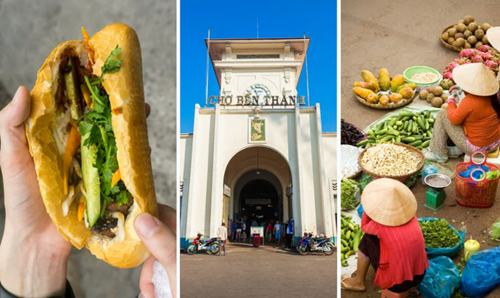
- Must-See Places:
- Hanoi: Dive into the street food scene and explore the Old Quarter.
- Halong Bay: Famous for its emerald waters and limestone islands, many tours are available at reasonable prices.
- Ho Chi Minh City: Explore the war history museums and vibrant markets.
- Budget Breakdown:
- Accommodation: Dorm rooms range from $5-$12; private guesthouses can be found for $15-$30.
- Food: Street food is abundant, with dishes like Pho costing $1-$2. Meals in restaurants average $3-$7.
- Transportation: Buses between cities are inexpensive ($5-$20), while local transport costs around $1-$2.
- Daily Budget Estimate:
- Total: $25 – $50 per day (budget traveler) / $50 – $100 (mid-range).
3. Cambodia
Home to the magnificent Angkor Wat, Cambodia is a beautiful country filled with history, stunning temples, and friendly locals.
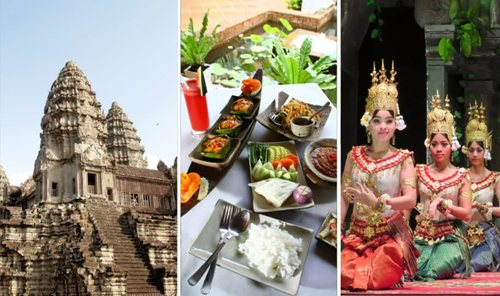
- Must-See Places:
- Siem Reap: The gateway to Angkor Wat; you can easily spend days exploring the temple complex.
- Phnom Penh: Visit the Royal Palace and the haunting Killing Fields for a historical perspective.
- Sihanoukville: Known for its beaches and nearby islands, offering a more laid-back experience.
- Budget Breakdown:
- Accommodation: Dorms can be found for $5-$10; budget hotels and guesthouses cost $10-$25.
- Food: Local restaurants offer meals for $3-$5, while street food can cost as little as $1.
- Transportation: Tuk-tuks are common, costing $2-$10 depending on the distance. Long-distance buses range from $5-$15.
- Daily Budget Estimate:
- Total: $20 – $50 per day (budget traveler) / $50 – $100 (mid-range).
4. Indonesia
Famous for its stunning beaches, vibrant culture, and breathtaking landscapes, Indonesia, particularly Bali, is a hotspot for budget travelers.
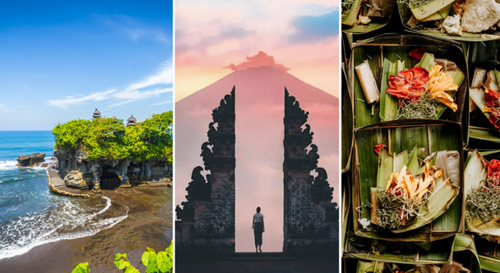
- Must-See Places:
- Bali: Explore temples like Uluwatu, enjoy the beaches of Kuta, and experience the rice terraces in Ubud.
- Jakarta: The bustling capital offers a mix of culture, food, and nightlife.
- Yogyakarta: Known for its historical sites and access to Borobudur and Prambanan temples.
- Budget Breakdown:
- Accommodation: Budget hostels are around $8-$15; guesthouses start at $15-$30.
- Food: Meals from warungs (local eateries) cost $2-$5; mid-range restaurants charge $5-$15.
- Transportation: Renting a scooter costs about $5-$10 per day. Local transport fares vary but are generally low.
- Daily Budget Estimate:
- Total: $25 – $60 per day (budget traveler) / $60 – $120 (mid-range).
5. Laos
Often overshadowed by its neighbors, Laos is a hidden gem with stunning natural beauty, a laid-back vibe, and rich cultural heritage.

- Must-See Places:
- Luang Prabang: A UNESCO World Heritage site known for its well-preserved architecture and beautiful waterfalls.
- Vang Vieng: Famous for its outdoor activities, including tubing, kayaking, and hiking.
- Vientiane: The capital city offers a more relaxed atmosphere with beautiful temples and a riverside promenade.
- Budget Breakdown:
- Accommodation: Dorms start at $5; private rooms are $10-$25.
- Food: Street food can be found for $1-$3; meals at restaurants cost $5-$10.
- Transportation: Local buses are about $1-$3, and renting a bicycle can be around $2-$5 per day.
- Daily Budget Estimate:
- Total: $20 – $40 per day (budget traveler) / $40 – $80 (mid-range).
6. Malaysia
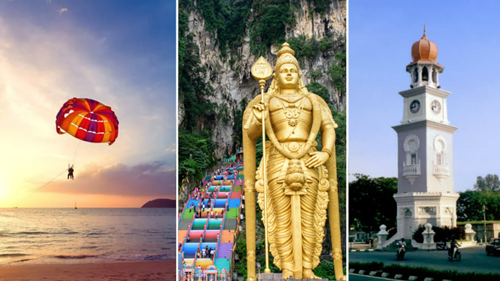
- Must-See Places:
- Kuala Lumpur: Visit the iconic Petronas Towers and explore the bustling markets.
- Penang: Known for its street art and food scene, it’s a cultural melting pot.
- Langkawi: A stunning archipelago known for its beaches and duty-free shopping.
- Budget Breakdown:
- Accommodation: Dorms cost around $10-$15; budget hotels range from $20-$50.
- Food: Street food and local eateries offer meals for $2-$5.
- Transportation: Buses between cities are affordable, usually around $5-$15, while local transport is inexpensive.
- Daily Budget Estimate:
- Total: $25 – $50 per day (budget traveler) / $50 – $100 (mid-range).
7. Myanmar
Myanmar, or Burma, is an emerging destination known for its rich cultural heritage and friendly locals.
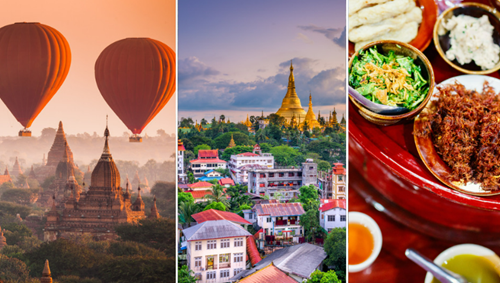
- Must-See Places:
- Bagan: Famous for its ancient temples and stunning sunrises.
- Yangon: Home to the iconic Shwedagon Pagoda and vibrant street markets.
- Inle Lake: Known for its scenic beauty and unique floating gardens.
- Budget Breakdown:
- Accommodation: Budget hostels start at $10; guesthouses range from $15-$40.
- Food: Local meals typically cost $2-$5.
- Transportation: Buses and trains are cheap, with fares ranging from $5-$20 for long-distance travel.
- Daily Budget Estimate:
- Total: $20 – $50 per day (budget traveler) / $50 – $100 (mid-range).
Conclusion
Southeast Asia is undoubtedly one of the cheapest travel destinations you can explore. With affordable accommodation, cheap transportation, delicious street food, and a plethora of attractions that won’t drain your wallet, it’s no wonder travelers flock to this region. Whether you’re wandering the ancient ruins of Angkor Wat, lounging on the beaches of Thailand, or exploring the vibrant markets of Vietnam, you can enjoy incredible experiences without overspending.
By planning wisely, setting a budget, and being open to new adventures, you can make the most of your time in this captivating region. So pack your bags, grab your passport, and prepare for an unforgettable journey through the cheapest travel destinations Southeast Asia has to offer!



